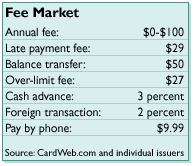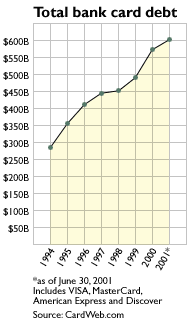
NEW YORK (CNN/Money) -
Since Bank of America began marketing its BankAmericard in the 1950s, the credit card has become as much a part of American culture as fast food and football.
We use plastic to pay for everything from cappuccinos to taxes. And we sleep better at night thinking that even if we have little in the bank, we can always count on our high credit limits to cushion any economic bumps in the road.
But here's a wake-up call: For many consumers, the price of credit is steep and growing. While issuers are quick to tease us with introductory rates and reward us for our loyalty, they are also quick to punish anyone who doesn't play by their rules.
Fees, they're everywhere you want to be
In February alone, the average late payment fee rose 3 percent to $29, marking the largest increase in the industry's history, according to CardWeb.com, which tracks and publishes information on credit cards. And a handful of issuers, including Citibank, Discover, Fleet and MBNA now charge tardy customers up to $35, depending on their balance.
| |
 TELL US YOUR DEBT STORY
TELL US YOUR DEBT STORY
| |
| | |
| If you've worked with a credit counseling or debt-consolidation service to lighten your debt load, tell us about your experience.
|
|
| • | E-mail us at debt@cnnmoney.com. We won't use your name without your permission.
|
|
|
| | |
|
"A lot of consumers are bumping into fees that either didn't exist before or have been greatly increased," said Robert McKinley, chief executive of CardWeb.com.
Even customers with the best intentions have a tough time avoiding fees, which now account for nearly 30 percent of issuers' income. Though many cards still charge no annual fee, many low-interest cards and most reward cards do. "Annual fees on frequent flyer cards range from $50 to $100," said Linda Sherry, spokesperson for the advocacy group Consumer Action.
Consumers who shuffle their debt from one card to the next were once the bane of the industry, but thanks to balance-transfer fees, their actions are just another source of revenue. Issuers now also pad all foreign currency transactions with a two percent commission and charge about three percent for cash advances. And a few, including Citibank, now charge $10 "convenience" fees for paying your bill by phone -- never mind that you're probably saving them money by doing so.

These fees add up. Say you pay $50 a year for Citibank's AAdvantage card, which earns miles for American Airlines. (The gold version is $85 a year.) You miss your payment date twice each year, for a $35 fee if your balance is over $1,000. Hungry for miles, you also use your card to pay for big-ticket items from time to time and go over your credit limit, a $29 fee. Not including any interest you pay, your card could easily cost you about $150 a year.
And for everything else, there's high interest
After peaking in 1991 at 71 percent, the percentage of cardholders who carry a balance steadily declined to 56 percent in 2000. (McKinley estimates that it will rise to 61 or 60 percent for 2001.) But even as more consumers paid down their debt, the average credit-card balance continued to climb. According to CardWeb.com, the average January balance for all households with at least one card was $8,367, which includes those who pay their bills in full every month.
Separate consumers who revolve their balances from convenience users -- those who pay their balance in full every month -- and the numbers are even more staggering. The average debt among revolvers is $12,000, according to Robert Manning, a professor of humanities at the Rochester Institute of Technology and author of Credit Card Nation.
"The fees and interest on this kind of balance add up to $2,000 a year," Manning said. He says that penalty rates are making it increasingly difficult for consumers with a high balance to pay down their debt. "For a small part of the population credit cards are a good deal, but for every person who pays 5 percent there is someone who pays 20 percent," said Manning. "The people who need low rates the most can't get them."

Indeed, issuers now tailor their terms to fit individual customer profiles. Those with stellar credit qualify for the best rates, while those with spotty credit pay a premium. In fact, the range of interest rates paid by individuals is broader than it's ever been, with post-teaser rates ranging from 4.75 percent to 35 percent, according to CardWeb.com.
"The industry has been steadily moving toward individual pricing. This is why you see many tiers on the individual pricing of a card," said McKinley.
To calculate how long it will take to pay off your balance and what you’ll pay in finance charges, click here.
Even if you do qualify for a low rate, you must be on your best behavior to keep it. According to a 2001 survey by Consumer Action, nearly 70 percent of all issuers said they would raise a customer's rate for paying late. Some issuers have taken this a step further and will raise rates if they see any change in your creditworthiness, says McKinley. This means that paying late on one credit card could also affect your rate on an entirely different card.
"Discover, Household, Citibank and Capital One have a very proactive approach to managing risk," said McKinley. "The regularly pool the credit files of their customers to see if there has been any major change."
The difference between the interest rate you signed on for and your new penalty rate can be substantial. Say you qualify for Capital One's no-hassle platinum card, with a fixed rate of 8.9 percent, carry a balance of $4,000 and pay $200 monthly. If you pay late twice in six months, your rate will go to 19.8 percent. It will take you two additional months to pay down your debt and cost you $796, or more than twice as much, in finance fees.
It pays to discover what you're really paying
While consumers are learning to manage new fees and capricious interest rates, credit card issuers are making money hand over fist. Overall, bank credit-card interest and fee income tripled in the 1990s, according to Manning. And 2001, though difficult for some issuers, was one of the most profitable years for the industry, with an average 4 percent return on assets. "Credit cards are the most profitable products a bank can offer," said Jim Accomando, president of Accomando Consulting. "With most bank products, return on investment is about 1 percent."
| |
 RELATED TOOLS
RELATED TOOLS
| |
| | |
| | |
|
Based on the solicitations piling up in your mailbox, you might think that competition almost guarantees consumers the best deal. Not so, says Manning. "The real cost of borrowing on credit cards has doubled since deregulation in 1980," he said, referring to the spread between the rate issuers pay to borrow money and what they charge consumers in interest.
It seems that issuers are counting on consumers to not question their rates or growing fees.
Accomando said customers have become too complacent. "If every one of these customers woke up and shopped around for the rate they deserve the industry would be hurting," he said.
McKinley agrees. "There has not been much resistance from consumers," he said. "Until consumers put up a fight, issuers will continue raising their prices."
Which is why you should not leave home without...Questioning your terms
The first thing you should do is make sure you're not paying more than you should for your card. If you never carry a balance, don't pay a high annual fee for a card with a low rate. Instead, look for a card with no annual fee or one that offers rewards.
| |
 Related stories
Related stories
| |
| | |
| | |
|
If you do carry a balance, consider skipping a high-rate rewards card and shopping for a basic card with a low rate instead. You may find that what you save in finance charges is worth more than the rewards. Try shopping locally for a small bank or credit union. Though you may have to forgo a high credit limit and 24-hour customer service, you could save money in interest. "Rates are more favorable at smaller institutions, and they're more forgiving with fees," said Greg McBride, an analyst for Bankrate.com.
The typical adult has three bank cards and four retail cards, according to Manning. If you bring that down to one or two cards, you'll not only save in annual fees, you'll have fewer payments to keep track of and have a more realistic idea of how much you owe.
"Dump the number of cards you carry in your wallet," said Accomando, who adds that people often fail to read the fine print on their individual store cards.
Even the most responsible cardholders can lose track of time and get hit with a late payment. An easy way to make sure you never pay a late fee is to have a small amount automatically drafted from your checking account each month. You can get an idea of how much you'll need to meet the minimum payment by multiplying your typical bill by 2 percent. This is no substitute for paying more than the minimum via the mail but it will protect you if you let the due date slip by you.

|

